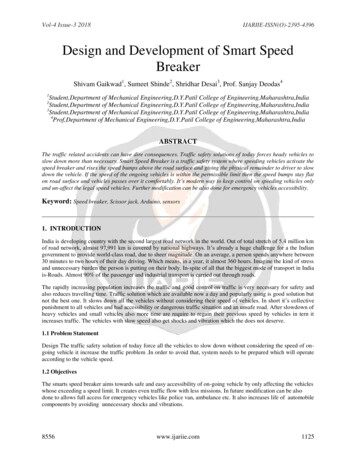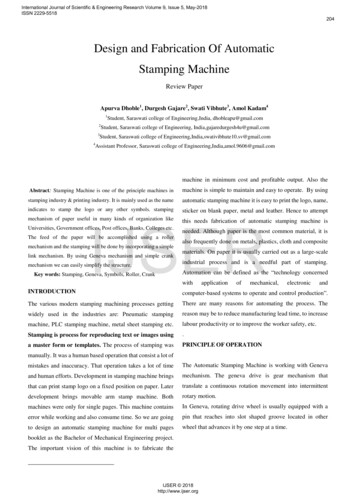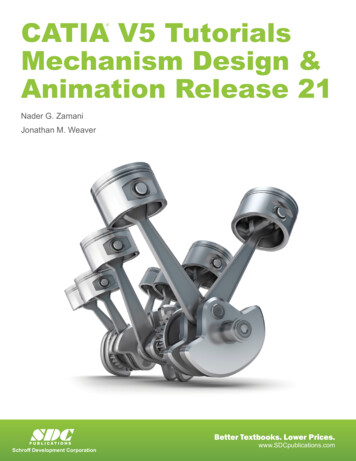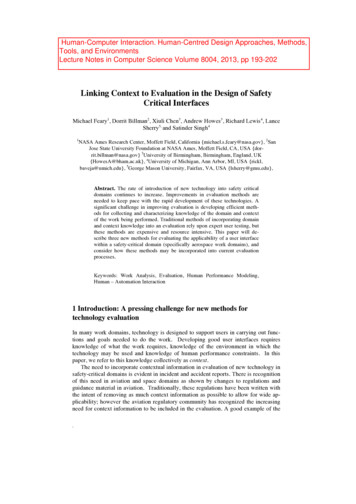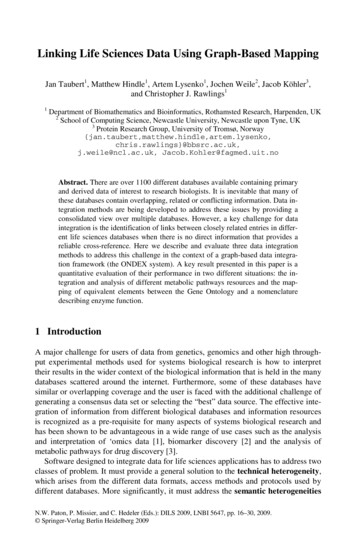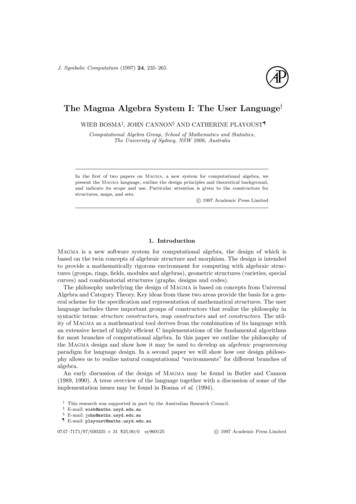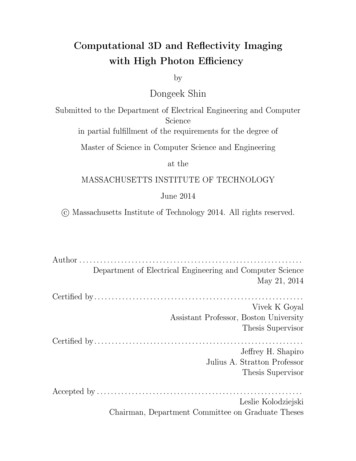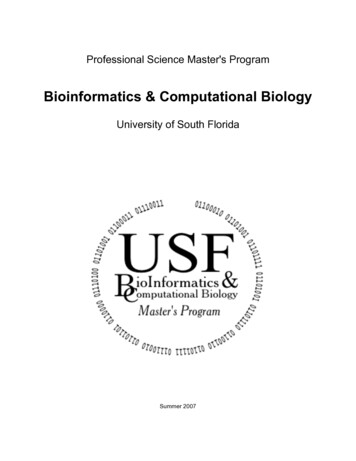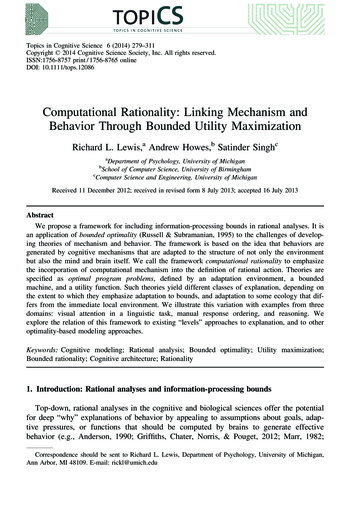
Transcription
Topics in Cognitive Science 6 (2014) 279–311Copyright 2014 Cognitive Science Society, Inc. All rights reserved.ISSN:1756-8757 print / 1756-8765 onlineDOI: 10.1111/tops.12086Computational Rationality: Linking Mechanism andBehavior Through Bounded Utility MaximizationRichard L. Lewis,a Andrew Howes,b Satinder SinghcaDepartment of Psychology, University of MichiganSchool of Computer Science, University of BirminghamcComputer Science and Engineering, University of MichiganbReceived 11 December 2012; received in revised form 8 July 2013; accepted 16 July 2013AbstractWe propose a framework for including information-processing bounds in rational analyses. It isan application of bounded optimality (Russell & Subramanian, 1995) to the challenges of developing theories of mechanism and behavior. The framework is based on the idea that behaviors aregenerated by cognitive mechanisms that are adapted to the structure of not only the environmentbut also the mind and brain itself. We call the framework computational rationality to emphasizethe incorporation of computational mechanism into the definition of rational action. Theories arespecified as optimal program problems, defined by an adaptation environment, a boundedmachine, and a utility function. Such theories yield different classes of explanation, depending onthe extent to which they emphasize adaptation to bounds, and adaptation to some ecology that differs from the immediate local environment. We illustrate this variation with examples from threedomains: visual attention in a linguistic task, manual response ordering, and reasoning. Weexplore the relation of this framework to existing “levels” approaches to explanation, and to otheroptimality-based modeling approaches.Keywords: Cognitive modeling; Rational analysis; Bounded optimality; Utility maximization;Bounded rationality; Cognitive architecture; Rationality1. Introduction: Rational analyses and information-processing boundsTop-down, rational analyses in the cognitive and biological sciences offer the potentialfor deep “why” explanations of behavior by appealing to assumptions about goals, adaptive pressures, or functions that should be computed by brains to generate effectivebehavior (e.g., Anderson, 1990; Griffiths, Chater, Norris, & Pouget, 2012; Marr, 1982;Correspondence should be sent to Richard L. Lewis, Department of Psychology, University of Michigan,Ann Arbor, MI 48109. E-mail: rickl@umich.edu
280R. L. Lewis, A. Howes, S. Singh / Topics in Cognitive Science 6 (2014)Stephens & Krebs, 1986). These assumptions can be understood as defining problems ofadaptive or rational behavior, and are formulated independently of the mechanisms thatmight be used to solve them (“how” explanations). This view is reflected in a key property of most meta-theoretical frameworks in cognitive science: a separation of higherrational levels that identify goals from lower mechanism levels that approximately implement those goals (Marr, 1982; Newell, 1982). In such accounts, observed gaps betweenhow the agent should behave in some environment and how it actually behaves areexplained in one of two ways. One way is to appeal to mechanism limitations that preclude the computation of optimal behavior (as in approaches emphasizing heuristics forchoice and problem solving; e.g., Gigerenzer & Selten, 2001; Newell & Simon, 1972;Simon, 1956, 1990). Another way is to redefine the problem of rational behavior, by positing goals or environments of adaptation different from the immediate local environment(as in many prominent rational analyses, and evolutionary psychology; Anderson &Schooler, 1991; Cosmides, Barrett, & Tooby, 2010; Oaksford & Chater, 1994). We depictthis standard view schematically in Fig. 1.Newell and Simon’s (1972) seminal work on problem solving provides a clearexposition of the distinction between rational and mechanistic explanations. They statethat “. . . one of our main tasks will be to understand what is demanded by the taskFig. 1. The standard view in cognitive science of how rational analysis links behavior and mechanism.Rational analyses may be conducted via a variety of techniques, including Bayesian analysis, and can produce predictions of optimal behavior that may be compared to observed behavior. Rational analysis levels arethe locus of “what” and “why” accounts and potentially explain behavior in a way that abstracts away frommechanism. Cognitive/neural mechanisms are assumed to provide approximate implementations of the goals/functions posited at the rational level. The execution of these mechanisms produces behaviors that may becompared with both observed behaviors and the behavior calculated by the rational analysis.
281R. L. Lewis, A. Howes, S. Singh / Topics in Cognitive Science 6 (2014)environment, so that we can understand—by elimination—what aspects of behavior aredetermined by the psychology of the problem solver” (p. 79). For example, the behaviorof a human making correct moves in an end-game of chess (as derived, perhaps, by anunbounded minimax algorithm) may be explained by what is demanded by the task andthe goal of winning, that is, a rational analysis. Departures from correct moves, or systematic biases in selecting among equally good moves, might be explained by appeal to aset of information processing mechanisms that approximate the function of winning—forexample, a bounded heuristic search process. These two kinds of explanations—rationaland mechanistic—represent the dominant ways of theorizing in cognitive science.The purpose of this paper is to make explicit and illustrate an alternative to this standard view—one that has significant theoretical advantages, while retaining the benefits ofrational analysis. The distinctive feature of this alternative is that it allows for information-processing capacities and bounds to be included as first-class elements of definitionsof rational behavior, formalized as problems of utility maximization. Fig. 2 illustrates thisalternative schematically. The early precedents of this alternative are signal detection theory (Tanner & Swets, 1954)1 and its development as ideal observer analysis (Geisler,2011); one of Simon’s (1955) early candidate definitions of bounded rationality2; Baronand Kleinman’s (1969) optimal control models of visual attention and manual control3;and Anderson’s (1990) original method of rational analysis.4We call this alternative computational rationality to emphasize the incorporation ofcomputational mechanism into the definition of rational action. The framework allows arigorous exploration of the idea that behaviors are generated by cognitive mechanismsthat are adapted to the structure of not only the environment but also the mind itself. Itplaces utility maximization at the heart of psychological theory, and we think it providesFig. 2. Computational rationality: an alternative view of how rational analysis links mechanism and behavior,based on bounded optimality. Unlike the standard approach in Fig. 1, the rational analysis makes direct contact with information-processing mechanisms by selecting an optimal program for a bounded machine thatmaximizes utility in some environment. The execution of the optimal program generates behavior that is theoptimal behavior for that machine; it cannot do better in the given environment. Although the output of theanalysis is an optimum, it is nevertheless directly constrained by the posited information-processing bounds,and the processes of optimization used in the analysis are not ascribed to the agent (rather they are tools ofthe theorist). The bounded optimal behavior may be compared to observed behavior as well as behavior calculated by unbounded rational analyses.
282R. L. Lewis, A. Howes, S. Singh / Topics in Cognitive Science 6 (2014)a useful way to unify psychology’s dual aims of generating explanations of behavior andgenerating explanations of cognitive mechanism. In a nutshell, the framework extends thequestion posed by standard rational approaches (what should a rational agent do in thisenvironment?) to include processing bounds: What should a rational (utility-maximizing)agent, with its available information-processing mechanisms, do in this environment?The technical innovation offered here is to apply bounded optimality—a preciselydefined concept in artificial intelligence (Russell & Subramanian, 1995)—to these explanatory aims. A bounded optimality analysis provides a clear answer to the question above:A bounded agent should do whatever the best program running on its informationprocessing architecture would do. We believe that this framing has value because of itsgenerality and the analytic rigor and clarity that it brings to the problems of stating andtesting the implications of different theoretical assumptions. We introduce the term computational rationality to refer to the application of bounded optimality to psychology, toavoid confusion with bounded rationality, which has come to be associated with a rejection of optimality analyses.In the remainder of the paper, we first present the framework of computational rationality, and show how it yields a broad space of useful explanatory theory. Theories andexplanations in this space differ in the extent to which they emphasize adaptation toinformation-processing bounds, and adaptation to some ecological environment that differs from the immediate local environment. Rich mixtures of both kinds of constraint arepossible. We introduce a minimal amount of formalism along the way, focusing on defining the key underlying concepts. Next, we illustrate the framework with three models inthe domains of response ordering, eye movements in a linguistic task, and logical reasoning, each of which illustrates a different kind of explanation. We conclude with a discussion of the relation of computational rationality to existing approaches in cognitivescience.2. Computational rationality as a framework for explanation and predictionIn this section, we apply computational rationality to the challenge of theorizing abouthuman cognitive mechanisms, behaviors, and ecologies. Computational rationality isstrongly influenced by bounded optimality (Russell & Subramanian, 1995). Russell andSubramanian (1995) defined a bounded optimal agent as one that is executing the program (from its space of possible programs) that maximizes some performance measure insome environments of interest. Understanding computational rationality therefore requiresa bounded rational analysis. It requires defining and solving an optimal program problem. This analysis provides an ontology of analytic elements that precisely defines suchnotions as agent bounds, goals, behaviors, and distinct ecological and evaluation environments. This ontology is summarized in Table 1, with examples of how the different elements map onto concepts from three familiar frameworks: signal detection theory,cognitive architectures, and classic rational analysis.
Bounded agent, M: An information-processingmachine with a set of possible observationsOM and actions AM . The machine computesmappings from histories of observations toactions, determined by the program executingon the machineBounded agent program space, P M : The spaceof possible programs that can run onmachine MBounded agent program, P: One of theprograms in P M . The program P and machineM together define an agent model 〈M,P〉 thatdetermines the policy computed by MPolicy or strategy, G〈M,P〉: A mapping fromobservation histories to (probabilistic) choiceof actions. A bounded machine with itsprogram space P M defines a space of possiblepolicies (mappings) that is a strict subset of allthe possible policies (mappings)Evaluation environment, Eeval: The (task)environment in which the agent exhibits thebehavior to be explained. An environmentmust define a distribution over next possibleobservations given a history of observationsand actionsEcological environments E and distributions,PðEÞ: The environment or distribution ofenvironments used to select aspects of theoptimal program for MElement and DefinitionA specific production ruleprogramComputed mapping fromMapping fromobservations to task responses observations to taskresponsesAn experimental task requiring A local experimental taskdefined in terms of a setsome interaction with aof abstract observationscomputer via mouse andand responses (e.g., seekeyboard (e.g., seeSection 3.3)Section 3.1)Usually identical to theevaluation environmentA specific choice of thresholdFunction mapping noisystimulus signals to Yes/NoresponsesAn experimental visualdetection experimentspecifying the frequencies oftargets and distractors.Usually identical to theevaluation environment(continued)Distributions of typicallyencountered objects outsidethe local environment EevalNoneNoneSet of all possible productionrule programsDetection thresholdsClassic Rational AnalysisDefines only OM and AMPerceptual, motor, cognitiveprocesses; memories, oftenwithout defining the machineryincluding a working memorythat computes mappings fromand a production rule memory histories to actionsCognitive ArchitecturesThresholded decision machinewith OM continuous signalrange, subject to some noise,and AM ¼ fyes; nogresponsesSignal Detection TheoryExamples From Familiar FrameworksTable 1The elements of a bounded rational analysis, with examples of how they might be instantiated in three familiar theoretical frameworks283R. L. Lewis, A. Howes, S. Singh / Topics in Cognitive Science 6 (2014)
Bounded optimal behavior: The behavior inEeval generated by M running the boundedoptimal program P*Bounded optimal policy, G*: The mappingfrom histories to actions computed by thebounded optimal program P*Behaviors or histories, h: Sequences ofobservations and actions generated byexecuting a policy in an environmentUtility (or goals), U: A function that mapshistories (behaviors) to some scalar measureof goodnessBounded optimal program, P*: The programin P M that maximizes expected utility in theecological environmentsElement and DefinitionClassic Rational AnalysisCorrect and errorresponses in the localtask environmentNoneNoneInformation gain (e.g.see Section 3.3)Task-related motor responses in Abstract local tasksome experimentresponsesCognitive ArchitecturesOften specified only informallyThe precise payoff matrix forin the task environmenthits, misses, false alarms,correct rejectionsThe optimal threshold given the Usually not derived, but if Upayoff matrix and noiseand E are made explicit, P* iswell-defined as the optimalproduction rule programThe mapping from noisy signals The mapping from observationsto responses implied by theto motor acts computed byoptimal thresholdoptimal production ruleprogramCorrect and error responseReaction times, error rates, etc.frequencies for both targetsin the task environmentand distractorsYes or no responses to astimulusSignal Detection TheoryExamples From Familiar FrameworksTable 1. (continued)284R. L. Lewis, A. Howes, S. Singh / Topics in Cognitive Science 6 (2014)
285R. L. Lewis, A. Howes, S. Singh / Topics in Cognitive Science 6 (2014)2.1. Defining and solving optimal program problemsOptimal program problems demand three inputs (Fig. 2): (a) a bounded agent; (b) anadaptation, or ecological, environment; and (c) a utility function. The solution to an OPPis (d) the optimal program(s) that, when executed on the bounded agent, will maximizeutility in the given adaptation environment. All four elements may carry theoretical content and be put to a variety of uses, as described next.2.1.1. Bounded information-processing agentsBy information-processing bounds or mechanisms, we mean the machinery thatcomputes mappings from perceptual inputs to effector outputs. This definition is broadenough to include constraints that are associated with both cognitive and perceptual/motorsystems, such as memory limitations and perceptual or motor noise (Faisal, Selen, &Wolpert, 2008), or the duration of primitive computations. Thus, nothing hinges on adistinction between “cognitive” and other types of bounds. But the definition is narrowenough to exclude machines that do not map between perception and action. Oneexample of a class of machines satisfying the definition are cognitive architectures in thesense advocated by Newell (1990), Meyer and Kieras (1997), and Anderson (2007).2.1.1.1. Definitions: We define a bounded agent as a machine M with a space of possibleobservations OM , a space of possible actions AM , and a space of programs P M that canrun on the machine. The agent is thus a machine that interacts with the environment viaa set of sensors providing OM and effectors realizing AM . Depending on the kind ofmodel being built by the scientist, the space of observations could be low level (e.g., retinal images) or high level (e.g., inputs already abstractly categorized). The space ofactions can be external motor actions (e.g., low-level muscle control signals) or high-levelabstract actions (e.g., a plan to travel to a distant city). The programs P M may includeinternal cognitive-processes—“mental actions” such as rehearsal, visual imagery and rotation, or memory retrievals.Choosing a program P 2 P M specifies an agent-model 〈M, P〉. When an agent-modelinteracts with some environment, it generates a history or trajectory of observations andactions. More precisely, it generates a random history at time t, denoted ht0 , which is thesequence of alternating observations and actions from the beginning of time, that is,ht0 ¼ o0 ; a0 ; o1 ; a1 ; . . .; ot 1 ; at 1 ; ot . We call such histories the behaviors of the agentmodel. (We assume the observation-action cycle happens in discrete time for ease ofexposition only.)An agent-model intensionally defines a policy or a mapping G〈M, P〉 from histories todistributions over actions, that is, for all tGhM; Pi : ðOAÞt O A ! ½0; 1 :ð1ÞWe will henceforth abbreviate G〈M, P〉 simply as G. Thus, the probability of action a in history ht0 is Gðht0 ; aÞ. Each machine-program combination induces a particular G-mapping.
286R. L. Lewis, A. Howes, S. Singh / Topics in Cognitive Science 6 (2014)In the context of a standard experimental cognitive psychology task, a policy can bethought of as a strategy for performing the task.We can now precisely state the distinction between bounded and unbounded machines.We denote the space of all computable mappings from histories to distributions over This represents the unbounded space of all agent-models that have observaactions as G.M is defined only in terms of OM and AM , and makes notion set O and action set AM . Greference to—and thus is not constrained by—the mechanisms in M. But any bounded which we denote as the (implicmachine M will implicitly select out a strict subset of G,itly bounded) subset G.At first glance, the notion that an agent-model is a fixed mapping (Eq. 1) seems ratherlimiting, but, in fact, this is the most general definition possible. It admits of any agentwhatsoever (within the constraints of discrete time interaction that can also be relaxed).In particular, it allows the agent-model’s behavior to be arbitrarily influenced by history,thus allowing for all manner of learning.52.1.1.2. Theoretical uses: The machine M may play a number of theoretical roles. It maydefine a comprehensive cognitive architecture, in the sense of ACT-R (Anderson, 2007),EPIC (Meyer & Kieras, 1997), or Soar (Laird, 2012; Newell, 1990) and thus entail ahuge space P M corresponding to the set of possible production rule programs. It maydefine a comprehensive architecture, but one whose program space is more narrowly limited to a range of policies or strategies of interest to the scientist. It may describe amachine architecture with bounds that represent assumptions about knowledge gainedfrom previous experience. It may describe a particular instantiation or subset of a broaderarchitecture, specifying just those bounds thought to be relevant to the analysis at hand. Itmay represent processing bounds at an extremely low level—perhaps resource constraintson neurotransmitters—combined with strategic adaptation parameters at a very high level.2.1.2. Ecological environmentAny assertion of optimality is relative to the definition of some environment to whichthe agent has adapted, an insight extensively leveraged in work on rational analyses (e.g.,Anderson & Schooler, 1991; Oaksford & Chater, 1994). The key insight here is that theoptimality, or otherwise, of an adaptive system should be partly determined by the statistics of the ecological environment to which the agent has adapted. For example, Anderson and Schooler argued that forgetting is optimal, given the probability of needing theinformation in the ecological environment, which decays as a power-law function of time.In such analyses, behavior can be understood as optimal relative to that ecology, but itmay appear to be suboptimal when observed in a local evaluation environment with differing statistical properties.2.1.2.1. Definitions: In the computational rationality framework, distributions over histories or behaviors are determined jointly by environments and agent models. We denotehistories h sampled from an agent-model 〈M, P〉 interacting with an environment E ash (〈M, P〉, E). We denote the environment in which the agent behavior is to be
287R. L. Lewis, A. Howes, S. Singh / Topics in Cognitive Science 6 (2014)explained as Eeval, and we denote as E the distribution of environments to which the agentis assumed to have been adapted, that is, which serves to select the set of optimal programs.2.1.2.2. Theoretical uses: The evaluation environment Eeval and adaptation environmentsE may play a number of theoretical roles. In the usual setting of an experimental cognitivepsychology task, E may be some mix of the immediate local environment—for example,the “training” or “practice” phase, and prior experience with the stimuli. In a classicrational analysis (e.g., the seminal analysis of conditional reasoning by Oaksford & Chater,1994, taken up in detail below), E may specify ecological distributions of objects andevents thought to be encountered in the agent’s lifetime. In an evolutionary biology setting, E may specify assumptions about “the environment of evolutionary adaptation”—atheoretical construct that need not be narrowly identified with a particular place or time(Tooby & Cosmides, 2005).2.1.3. Utility functions2.1.3.1. Definitions: We use a utility function U to determine the goodness of programsthat control behavior. U maps histories h from the set of possible histories H to somescalar:U:H!Rð2ÞNote that U is predicated on behaviors—interactions with the environment—not mechanisms. The implication for mechanism is through the selection of the optimal programthat maximizes expected utility, made precise below in Eq. 3.The approach thus follows many formal approaches to modeling behavior that requireutility and reward functions (e.g., optimal control theory (e.g. Stengel, 1994); dynamicprogramming (Bellman, 1957); decision theory (Von Neumann & Morgenstern, 1947);reinforcement learning (Sutton & Barto, 1998)).2.1.3.2. Theoretical uses: The utility function may play a number of theoretical roles. In astandard experimental psychology setting, it may specify the agent’s task goals, whichmight be given an objective grounding in the instructions. In may also specify a theory ofinternal subjective utility, including factors such as novelty traditionally ascribed to “intrinsic motivation” (Singh, Lewis, Barto, & Sorg, 2010), temporal discounting, or sensitivity torisk. It may specify desired speed–accuracy trade-offs, which may have subjective or objective grounding (or both). In evolutionary biology settings, the utility function may specifyassumptions about what determines organism fitness. In a cultural evolution settings, theutility function may also specify assumptions about what determines organism fitness.2.1.4. Bounded optimal programs and behaviorsTogether, an ecological environment distribution E, information-processing machine M,and a utility function U fully specify an optimal program problem.
288R. L. Lewis, A. Howes, S. Singh / Topics in Cognitive Science 6 (2014)2.1.4.1. Definitions: Solving this problem requires identifying the set of optimal pro grams P M ¼ fP g, defined by the following bounded optimality equation, adapted fromRussell and Subramanian (1995):no hM; P M i ¼ fhM; P ig ¼ arg max EE PðEÞ Eh ðhM; Pi; EÞ UðhÞ :ð3ÞP2P Mwhere the inner expectation is over histories (behaviors) in some environment and theouter expectation is over a distribution of environments. Each 〈M, P*〉 defines an optimalpolicy G* and so the set of optimal policies G ¼ fG g ¼ fhM; P ig.Again, the identification of optimal program problems may play a number of theoretical roles that depend on the nature of the theories of the bounds, environments,and utility function. The optimization step may be taken as an abstraction over avariety of possible natural adaptation mechanisms, including biological and culturalevolution, and individual agent learning. In particular, it identifies the limits of thoseadaptive processes, given the posited bounds. For example, in the typical setting of acognitive psychology experiment, where the utility function U encodes assumptionsabout immediate local task goals, and the adaptation environment E may includetraining trials or indeed the entire evaluation environment, solving Eq. 3 is a way ofabstracting over any number of adaptive mechanisms, including procedural reinforcement learning, instruction taking, local look-ahead planning, and cultural transmission.An optimal program problem is thus a way to specify a problem that has some stability over a region of time and space such that some adaptive mechanism(s) of interestmay operate.The output of the optimization ({〈M, P*〉}) itself may be put to a variety of uses. If thecognitive mechanisms themselves are of interest, then what is important is that({〈M, P*〉}) constitutes a derivation of mechanism, and its structure may be analyzed. Ifstrategies (policies) are of interest, then what is important is that {〈M, P*〉} computes theset of optimal strategies (policies) G given the bounds, and the structure of these strategies may be analyzed. If behavior (histories) are of interest, then what is important is that{〈M, P*〉} derives a distribution of behaviors h (〈M, P〉, E) in environments, and properties of this behavior can be analyzed, including correspondence to observed biologicalbehaviors in some evaluation environment.2.1.5. Important properties of bounded rational analysisThere are three crucial points that must be understood to avoid misinterpreting what abounded raitional analysis does:1.It is important to distinguish two kinds of computational costs: the cost of finding the optimal program, and the cost of executing the optimal program. Ingeneral, the individual agent need not be assumed to have arrived at the optimalprogram through an internal process of “optimization” over the posited programspace P M , and the method of solving Eq. 3 itself carries no theoretical content. Put
2892.3.R. L. Lewis, A. Howes, S. Singh / Topics in Cognitive Science 6 (2014)another way, the computational cost (or time- and space-complexity) of the algorithm used by the scientist to solve the OPP is not borne by the agent. The computational complexity of the selected optimal program is ascribed to theagent—because the optimal program executing on the agent’s processing architecture constitutes the cognitive mechanisms asserted to produce the agent’s behavior.The former computational cost is by definition associated with “optimization”; thelatter need not be.It is important to distinguish between the optimality of programs and the optimality of choices or behaviors. What is selected by Eq. 3 is a program (or set ofprograms), and not behavior—although of course the program has implications forbehavior. Optimal programs can be given a precise definition that takes intoaccount the constraints of the information-processing machine; optimal behaviorcannot (without implicitly adopting the optimal program perspective). This distinction is the foundational insight of Russell and Subramanian (1995): An agent isbounded optimal if its program is a solution to the constrained optimization problem presented by its architecture and the task environment.The data to be explained play no role in the optimal program derivation. Thus,it is not an analytic error to simply set E ¼ fEeval g, because only U, and not fit todata, is used to select P*. All of the explanatory power of the bounded optimalityanalyses rests on this distinction. Nevertheless, bounded optimality analyses may beused in concert with methods for estimating parameters of the bounded machinefrom data. We illustrate two such methods in the examples that follow.2.2. Varieties of explanationsDifferent choices of information-processing machine and environments of adaptationwill lead to different kinds of optimality-based explanation. We focus here on four natural subtypes that arise by varying the optimal program problem inputs in discrete ways.In practice models and explanations may be some mix of these types, but it is useful tolay out the simplest cases. Note that classes III and IV, but not classes I and II, defineclasses of theory in which it is assumed that an organism is computationally rational.2.2.1. Optimality explanationsConsider first the case where the machine M is unbounded (that is, the program space and theP M does not restrict the set of possible computable mappings, and so G ¼ G)adaptation environment is the evaluation environment (E ¼ fEeval g). Then solving Eq. 3derives the best possible policy that an agent with observations OM and actions AM couldin principle execute in Eeval. To the extent that the predicted behaviors or policy structureresulting from this ana
281 R. L. Lewis, A. Howes, S. Singh/Topics in Cognitive Science 6 (2014) a useful way to unify psychology’s dual aims of generating explanations of behavior and generating explanations of cogn

